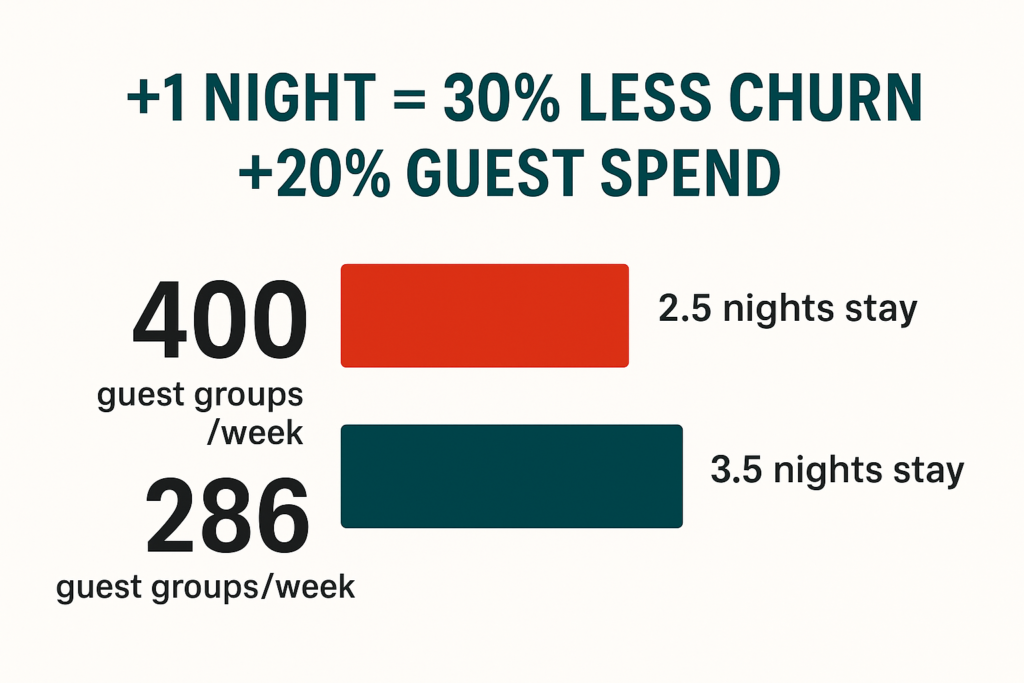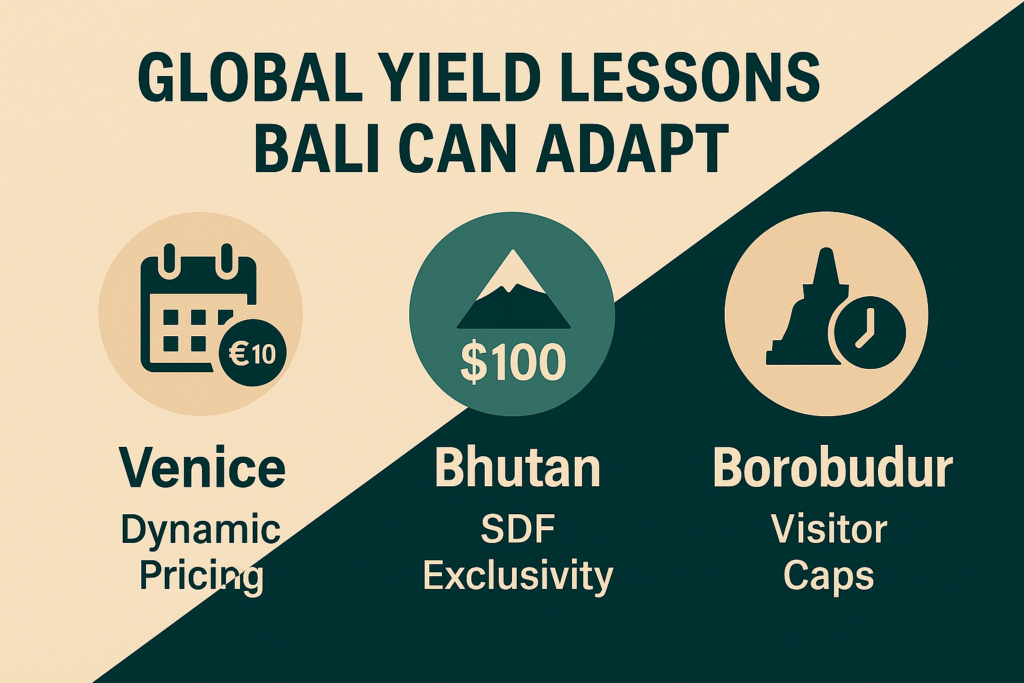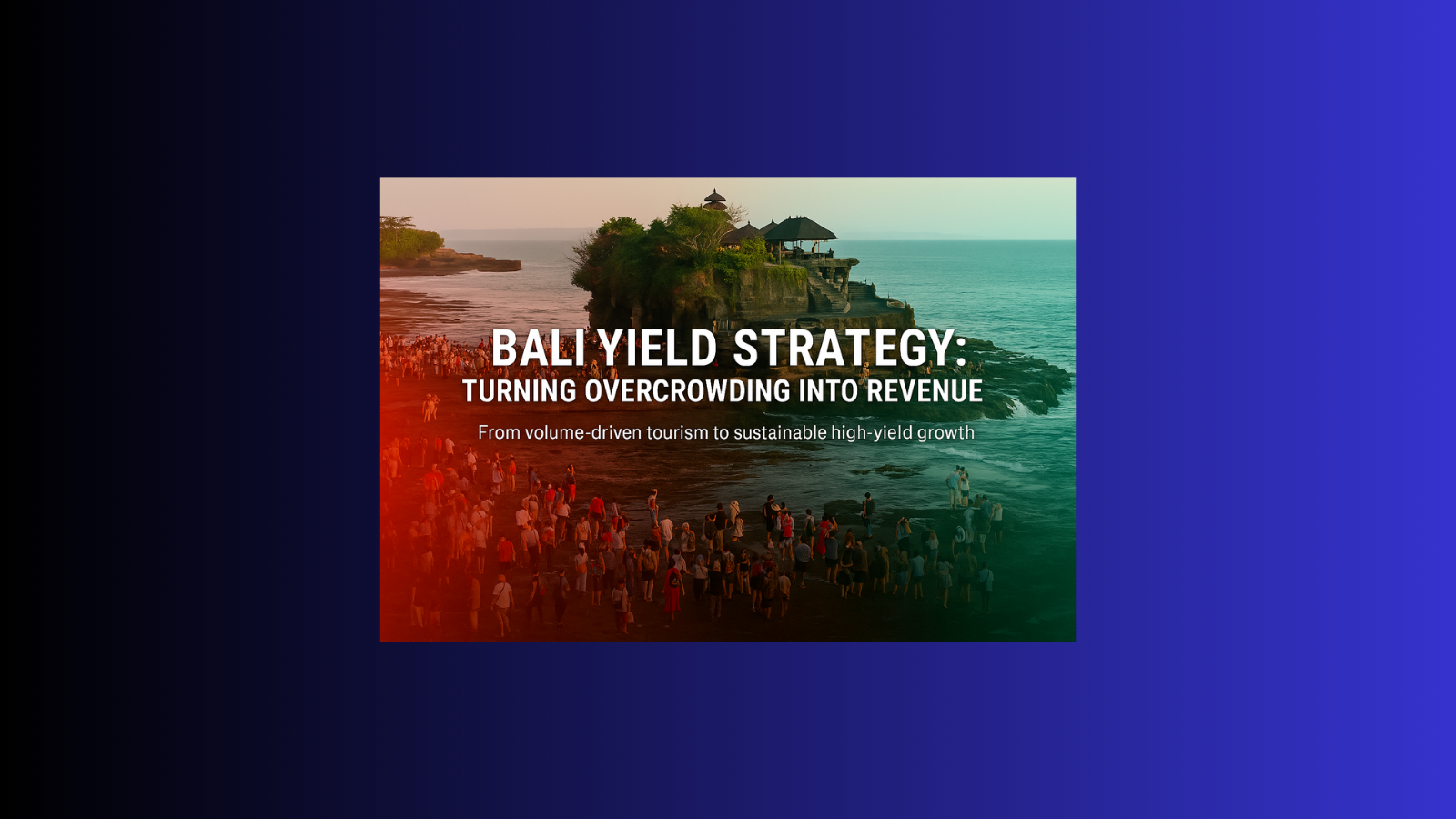Introduction
Bali’s popularity is both its greatest asset and its biggest challenge. To solve rising congestion and shorter stays, the island needs a clear Bali yield strategy—one that shifts the focus from raw visitor numbers to higher revenue per guest. Over the past 15 years, international arrivals have surged by 121%, while domestic arrivals jumped 240% (Radit Mahindro). Yet during the same time, the average length of stay has shrunk—down ~39% for domestic visitors and ~24% for internationals.

The result is shorter stays and larger crowds: more check-ins, more traffic, more strain on infrastructure, and ultimately less per-visitor spend.
The Balinese government has already acknowledged this reality. Through measures like the new IDR 150,000 tourist levy, officials have begun signaling a shift to “quality over quantity” (Responsible Travel). This makes now the perfect time to rethink strategy.
Instead of chasing raw arrival numbers, Bali can flip the challenge into an opportunity through a Bali yield strategy—a framework focused on higher revenue per visitor, longer stays, and smarter dispersal.
👉 For background, see our full analysis: Managing Destination Overcrowding in Bali: A Strategic Call to Action.
1. The Problem: Why Bali Needs a Yield Strategy
- International arrivals: +121% over 15 years
- Domestic arrivals: +240% in the same period
- Average length of stay: Down from 2.9 nights in 2019 to 2.5 nights in 2023 (Hotelivate)
- May 2025 LOS (BPS Bali): Foreign tourists ~2.8 nights; domestic often <2.5 nights (BPS Bali)
Shorter stays equal higher churn and lower yield. More guests cycling through means more trips to the airport, more congestion at temples and beaches, and less F&B or wellness revenue per guest.
2. Policy Tailwinds: The Foundation for Yield
Bali has already taken steps that open the door for a yield-first approach:
- Tourist Levy (IDR 150,000): Launched in February 2024 (LoveBali), it sets the precedent that visitors pay for preservation and quality.
- Behavioral Guidelines: “Do’s & Don’ts” videos on inbound flights encourage tourists to respect local culture (Invest Indonesia).
- National Quality Focus: Indonesia’s Ministry of Tourism has shifted messaging toward attracting longer-stay, higher-spend visitors.
These signals align perfectly with a structured Bali yield strategy.
3. Three Pillars of a Bali Yield Strategy
A. Dynamic Pricing at Crowded Sites
- Charge premium entry fees at peak hours for iconic temples and attractions.
- Follow the model of Venice’s €5–10 tourist fee (City of Venice).
- Replicate Borobudur’s visitor cap (1,200/day) with timed entry (Kompas).
B. Incentivizing Longer Stays
- Hotels and villas can offer “Stay 5 Pay 4” or bundled spa and wellness perks for longer bookings.
- If the average length of stay rises from 2.5 to 3.5 nights, weekly churn drops by 30%—relieving congestion and boosting yield.
- Destination-wide, campaigns like “Bali x7 Nights” can frame longer stays as part of cultural preservation.
C. Smart Dispersal with Data
- Redirect demand toward North and East Bali during peak South/Ubud crowding.
- Encourage two-base itineraries (e.g., 3 nights Seminyak + 4 nights Amed).
- Use OTA and search data to dynamically promote less crowded alternatives.
👉 This dispersal approach has already been validated in our analysis of neighboring islands: Lombok Tourism Growth Strategy.

4. Global Case Studies Bali Can Learn From
- Venice: Dynamic entry fees for day-trippers to spread demand (Euronews).
- Amsterdam: A 12.5% hotel tax and cruise surcharges to discourage nuisance tourism (Iamsterdam).
- Bhutan: A high nightly Sustainable Development Fee to position for exclusivity (Tourism Council of Bhutan).
- Borobudur: Daily caps and timed entry proving capacity management is feasible in Indonesia.
Each of these examples reinforces how a yield-first model can turn overcrowding into a strength.
5. Why a Bali Yield Strategy Is Good Business for Investors
A Bali yield strategy isn’t just about policy—it has clear financial upside:
- Longer stays = higher trip spend. Guests who stay 3.5 nights instead of 2.5 nights spend 20%+ more on F&B, wellness, and activities.
- Lower churn = smoother operations. 30% fewer check-ins reduces staffing peaks, airport transfers, and tour bottlenecks.
- Higher yield = more resilient ROI. Revenue per available visitor (RevPAV) rises even if arrivals plateau.
For hospitality investors, this means projects designed with yield in mind will outperform in both occupancy pressure and regulatory resilience.

FAQ – Overcrowding & Yield Strategy in Bali
Q1: What is a Bali yield strategy?
It’s a framework that increases revenue per visitor by focusing on pricing, longer stays, and dispersal—rather than pure volume growth.
Q2: Why is overcrowding a problem in Bali?
Tourism arrivals doubled in 15 years, but average stays got shorter, causing higher churn, congestion, and lower per-visitor spend.
Q3: How does dynamic pricing help?
Charging more at peak times both controls crowding and increases revenue, while nudging guests toward off-peak visits.
Q4: What can hotels and villas do?
Offer minimum stay incentives (discounts for 5+ nights) to reduce turnover and increase ancillary spending.
Q5: How does dispersal marketing work?
It promotes less crowded regions of Bali and shoulder seasons to balance demand across the island.
Partner With Zenith Hospitality Global
Overcrowding doesn’t have to be the end of growth—it can be the start of a smarter future for Bali. By shifting from volume-driven arrivals to a Bali yield strategy, destinations and investors can unlock higher revenue, protect guest experience, and ensure long-term sustainability.
☑ Request your consultation — we’ll map a yield-focused ROI plan tailored to your property.
💬 Contact us directly on WhatsApp to discuss how your project can align with Bali’s new quality tourism vision.
🔗 Follow us on LinkedIn for insights, case studies, and yield strategies from across Indonesia.
Don’t risk your investment in a market under pressure. Work with a business consultant in Bali who ensures your project is 100% compliant and 100% yield-optimized.
👉 Contact Zenith Hospitality Global today to build a hospitality project that thrives in Bali’s new era of quality over quantity.





